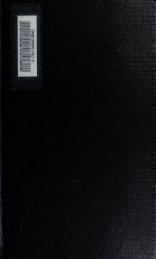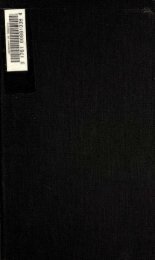Texts from the Buddhist canon : commonly known as Dhammapada
Texts from the Buddhist canon : commonly known as Dhammapada
Texts from the Buddhist canon : commonly known as Dhammapada
You also want an ePaper? Increase the reach of your titles
YUMPU automatically turns print PDFs into web optimized ePapers that Google loves.
INTRODUCTION. 7<br />
this more fully, <strong>the</strong> World-honoured One added <strong>the</strong><br />
following stanz<strong>as</strong> :<br />
"o<br />
—<br />
' Lusti or carnal desire, this is <strong>the</strong> Mo<strong>the</strong>r,<br />
" Ignorance," this is <strong>the</strong> Fa<strong>the</strong>r,<br />
The highest point of knowledge, this is Buddha,<br />
All <strong>the</strong> " Klesh<strong>as</strong> " <strong>the</strong>se are <strong>the</strong> Rahats,<br />
The five Ska'ndh<strong>as</strong>, <strong>the</strong>se are <strong>the</strong> Priests,<br />
To commit <strong>the</strong> five unpardonable sins<br />
Is to destroy <strong>the</strong>se five<br />
And yet not suffer <strong>the</strong> pains of hell.'<br />
»<br />
These comparisons will be sufficient to show <strong>the</strong> plan<br />
of <strong>the</strong> ^ork under consideration, and to confirm <strong>the</strong><br />
statement of <strong>the</strong> writer of <strong>the</strong> preface, " that <strong>the</strong>se<br />
stanz<strong>as</strong> are but choice selections <strong>from</strong> <strong>the</strong> various<br />
Sutr<strong>as</strong>."! WTg shall now understand <strong>the</strong> remark that<br />
" <strong>the</strong>re are various arrangements or editions of <strong>the</strong> Dham-<br />
mapada " (Chinese Preface^, for it seems plain that <strong>the</strong>se<br />
selections <strong>from</strong> <strong>the</strong> <strong>canon</strong>ical books were not made at any<br />
one time, or generally accepted in <strong>the</strong>ir present form,<br />
until a much later period than <strong>the</strong> compilation of <strong>the</strong><br />
Sutr<strong>as</strong> <strong>the</strong>mselves. The language of <strong>the</strong> Preface is<br />
equally distinct on this point, " It w<strong>as</strong> <strong>from</strong> <strong>the</strong>se works,<br />
viz., <strong>the</strong> Canonical Scriptures, that <strong>the</strong> Shamans in after<br />
ages copied out various G&th<strong>as</strong>, some of four lines, and<br />
some of six lines,2 and attached to each set of verses<br />
a title accordiug to <strong>the</strong> subject <strong>the</strong>rein explained." We<br />
may thus account for <strong>the</strong> various editions of <strong>the</strong> work<br />
which exist in China, compiled <strong>from</strong> original versions in<br />
India, shewing that <strong>the</strong>re existed in that country also not<br />
one, but several copies of <strong>the</strong>se "excerpta." We must<br />
accept <strong>Dhammapada</strong> <strong>the</strong>n in its present form, simply <strong>as</strong> a<br />
redaction made at an early period <strong>from</strong> <strong>canon</strong>ical books,<br />
for <strong>the</strong> purpose of ready reference, or <strong>as</strong> a religious " vade-<br />
mecum!'<br />
1 Which Sfttr<strong>as</strong> form <strong>the</strong> second of ^ These lines probahly correspond<br />
<strong>the</strong> three b<strong>as</strong>kets of <strong>the</strong> <strong>Buddhist</strong> to those named by Spenoe<br />
(E<strong>as</strong>tern Monach, p. 28).<br />
Hardy,<br />
Canon.<br />
"<br />
—





